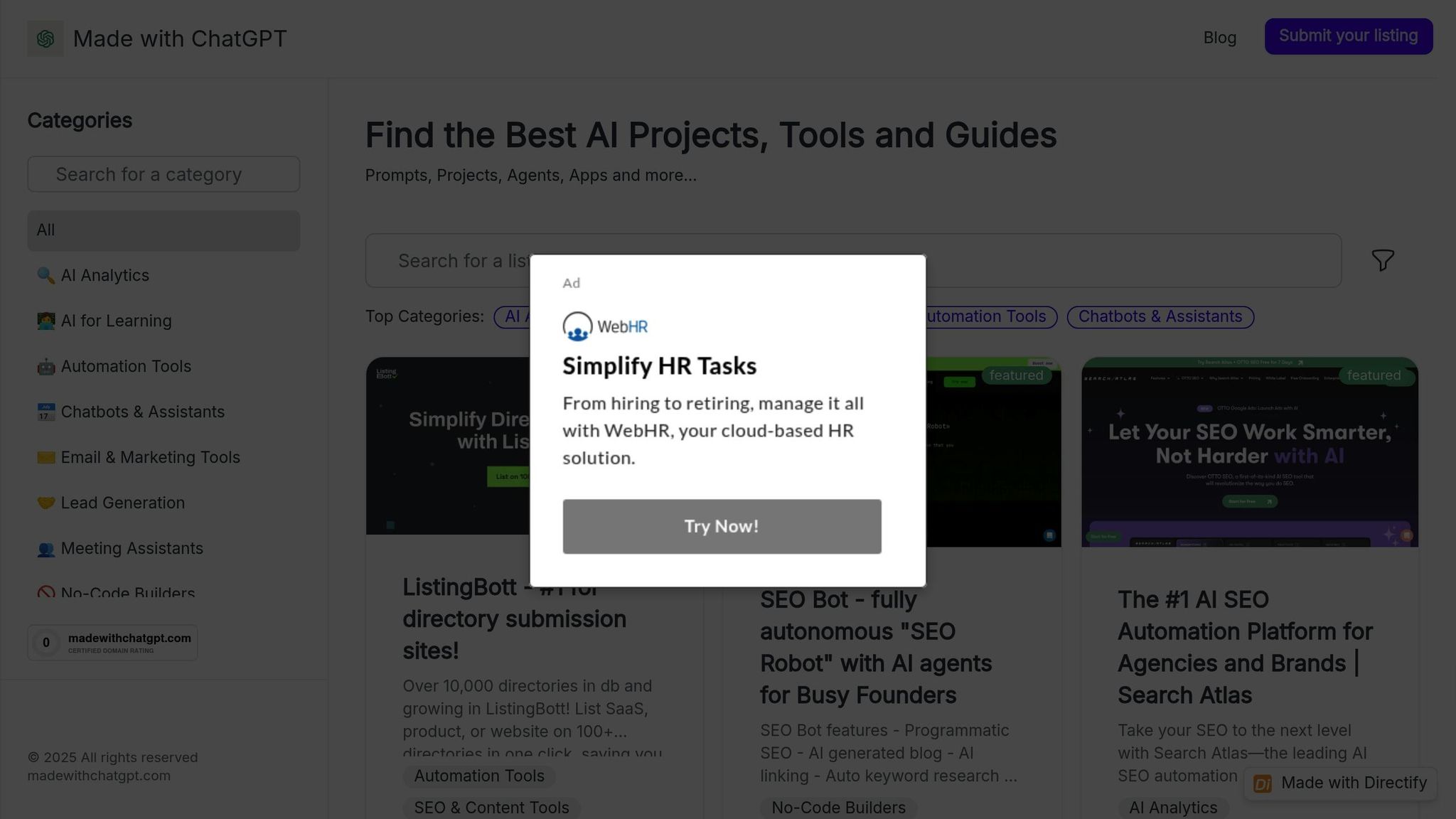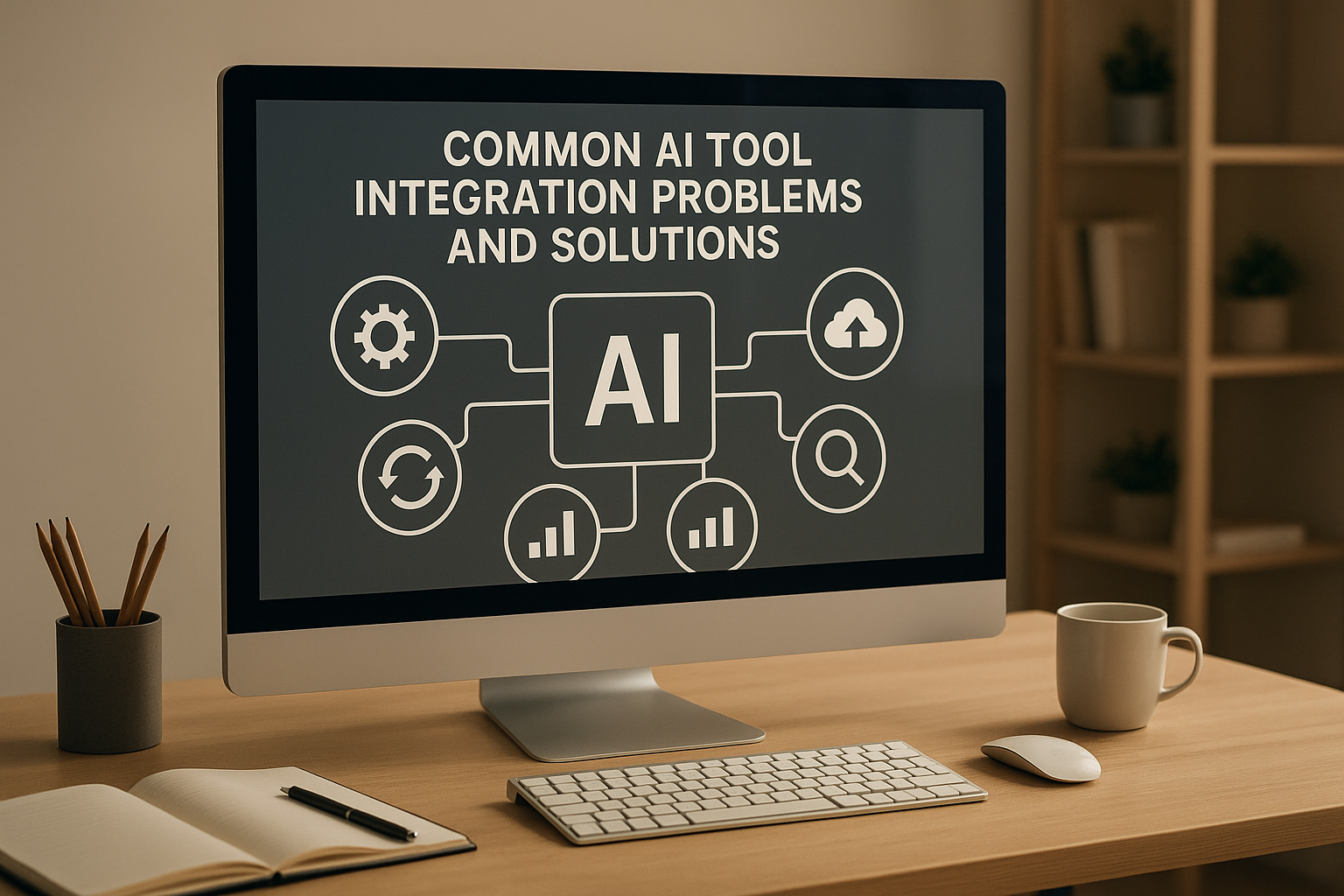AI tools can boost productivity, but integration challenges often get in the way. Here’s a quick breakdown of the most common issues and how to fix them:
- Technical Compatibility: Problems like outdated browsers, conflicting APIs, or insufficient hardware can disrupt integration.
- Data Security Risks: Encryption, access control, and compliance are essential to protect sensitive information.
- User Adoption: Poor interfaces, complex navigation, and limited customization make tools harder to use.
How to Solve These Issues:
- Technical Fixes: Update browsers, ensure systems meet requirements (e.g., 8GB RAM, 10 Mbps internet), and schedule regular maintenance.
- Strengthen Security: Use strong passwords, role-based access, and audit user permissions regularly.
- Improve Usability: Offer training, simplify workflows, and enable customization options like templates and shortcuts.
Want help finding the right AI tools? Platforms like Made with ChatGPT provide categorized directories, detailed guides, and filters for quick setup and smooth integration.
Navigating AI Integration: Strategies for Success
Common Integration Problems
When businesses implement ChatGPT-powered tools, they often encounter challenges that can slow down or complicate the process. Understanding these common issues can help identify areas that need attention for smoother integration.
Technical Compatibility Issues
Technical hurdles often arise due to differences in system architecture and infrastructure. These challenges can include:
- API Integration Conflicts: Older systems might struggle to communicate effectively with modern AI interfaces, leading to delays in data transfer and errors in processing.
- Browser Compatibility: Outdated web browsers may not support necessary JavaScript frameworks, causing functionality problems.
- Resource Allocation: AI tools demand significant processing power and memory, which can put a strain on existing hardware.
Data Security Risks
Protecting data is a critical concern during integration. Here are some key points to consider:
- Data Transmission Security: All data transfers should be encrypted to prevent interception.
- Access Control: Implement strong authentication methods to manage user access securely.
- Compliance Requirements: Ensure the system meets industry regulations and data protection standards.
User Interface Limitations
A poorly designed interface can discourage users and reduce the effectiveness of the tool. Common problems include:
- Complex Navigation: Overly complicated navigation can frustrate users. A user-centered design approach can make tools easier to adopt.
- Inconsistent Design: Mismatched layouts or interface elements can confuse users and create a disjointed experience.
- Limited Customization: When users can't tailor settings to their needs, it can limit the tool's usefulness.
Addressing these interface issues early in the process can enhance user satisfaction and improve how effectively the tool is utilized.
How to Fix Integration Problems
Here’s how to tackle the challenges we discussed earlier.
Fixing Technical Issues
Address compatibility problems with these steps:
Browser Updates and Extensions
- Keep your browser up to date, remove conflicting extensions, and clear the cache regularly.
System Requirements
Make sure your system meets these basic needs:
- Memory: At least 8GB RAM
- Internet Speed: Minimum of 10 Mbps
- Operating System: Fully updated with the latest security patches
- Maintenance: Follow a regular schedule for updates and checks
Once everything is set up, ensure your data flow is secure.
Improving Data Security
Strengthen your system’s security with these strategies:
Access Control Protocol
- Use strong password authentication.
- Set up role-based access for users.
- Perform monthly audits to review access levels.
| Security Level | Access Rights | Monitoring Frequency |
|---|---|---|
| Basic User | Can view and input data | Monthly activity reviews |
| Power User | Can create and modify workflows | Weekly usage reports |
| Admin | Full system access | Daily security logs |
Making Tools Easier to Use
Once technical and security issues are covered, focus on usability.
Training and Support
- Provide short guides and video tutorials.
- Assign “AI champions” in each department to assist others.
- Hold monthly feedback sessions to identify pain points.
Workflow Integration
Start Simple
- Begin with easy-to-use applications.
- Set up feedback loops to refine processes over time.
Customization Tips
- Adjust tool settings to match your workflow.
- Use templates for repetitive tasks.
- Enable features like keyboard shortcuts, auto-save, and backups for smoother operations.
sbb-itb-5ab00cc
Using Made with ChatGPT for Better Integration

Finding the right AI tools and making them work for you doesn't have to be a headache. Made with ChatGPT simplifies the process with a well-organized directory of tools, sorted into clear categories and detailed listings.
Selecting the Best Tools
Made with ChatGPT organizes tools based on their purpose - like AI Analytics, Automation, Chatbots & Assistants, and Marketing. Plus, you can filter options by how much automation they offer, their technical setup, and how they integrate into your current systems.
| Category | Purpose | Key Features |
|---|---|---|
| AI Analytics | Data processing and insights | API access, automation capabilities |
| Automation Tools | Streamlining workflows | Integration options, customization |
| Chatbots & Assistants | Customer service and support | Response speed, multilingual support |
| Marketing Solutions | Managing campaigns | Analytics integration, automation tools |
To make your search easier, you can apply filters like:
- Automation Level: Tags such as "Automates Outreach" or "Analyzes Data"
- Technical Requirements: Look for options labeled "API Available"
- Implementation Needs: Focus on tools marked "AI-Powered" that align with your setup
Once you’ve found a tool that fits, integration guides help you get it up and running quickly.
Following Integration Guides
Each listing includes:
Tool-Specific Details
- Clear descriptions of features
- Examples of how the tool can be used
- Information about technical requirements
Implementation Help
- Step-by-step guidance tailored to the tool’s category
- Compatibility details for features
- Specific setup instructions for integration
"Every listing and guide is curated by me, and I use these tools in my own business!" - Stephen, Founder of Made with ChatGPT
This approach makes it easier to find tools that fit your workflow while reducing the hassle of setting them up.
Conclusion
To wrap up, implementing AI tools effectively requires attention to both technical details and practical challenges. The directory on Made with ChatGPT serves as a useful resource for tackling common issues while tailoring solutions to your specific needs. This approach ensures your AI integration remains secure and easy to use, aligning with the steps outlined earlier.
Made with ChatGPT offers a categorized directory and in-depth guides to help you sidestep potential obstacles during implementation. Its filtering system lets you zero in on tools that meet your technical and automation goals - whether you're focused on analytics, streamlining workflows, or enhancing customer service.
FAQs
Ensuring AI tools are compatible with older systems requires careful planning and adjustments. Start by evaluating the technical specifications of your existing systems to identify potential compatibility issues. Focus on areas like operating systems, hardware limitations, and software dependencies.
To address compatibility challenges:
- Use middleware or APIs: These can act as a bridge between the AI tool and your legacy systems, enabling smooth communication.
- Update where feasible: Upgrade essential components of older systems to meet minimum requirements without overhauling the entire setup.
- Opt for customizable AI tools: Many tools offer flexible integration options to adapt to different environments.
Testing is also crucial - run the AI tool in a controlled environment to ensure it functions properly before full deployment. These steps can help streamline integration and maximize the benefits of AI tools in your existing workflows.
To ensure compliance with data protection regulations when integrating AI tools, businesses should start by understanding the specific legal requirements applicable to their industry and location, such as GDPR, CCPA, or other relevant frameworks. This helps establish a baseline for compliance.
Key steps include:
- Conducting a data audit: Identify what data the AI tool will process, how it will be stored, and who will have access.
- Implementing safeguards: Use encryption, access controls, and anonymization techniques to protect sensitive information.
- Reviewing vendor policies: Ensure the AI tool provider adheres to strict data security standards and offers transparent terms of service.
It’s also a good idea to regularly train your team on data privacy best practices and to consult with legal or compliance experts to address any specific concerns.
Encouraging employees to adopt new AI tools requires clear communication, proper training, and ongoing support. Start by explaining the benefits of the tool, such as saving time, improving productivity, or simplifying tasks, and how it aligns with the organization's goals. Address any concerns proactively, like data privacy or job security, to build trust.
Provide hands-on training sessions and easy-to-follow guides to help users become comfortable with the tool. Designate internal champions or team leads who can advocate for the tool, answer questions, and assist with troubleshooting. Additionally, gather feedback regularly to identify pain points and make adjustments as needed, ensuring the tool meets employees' needs effectively.


